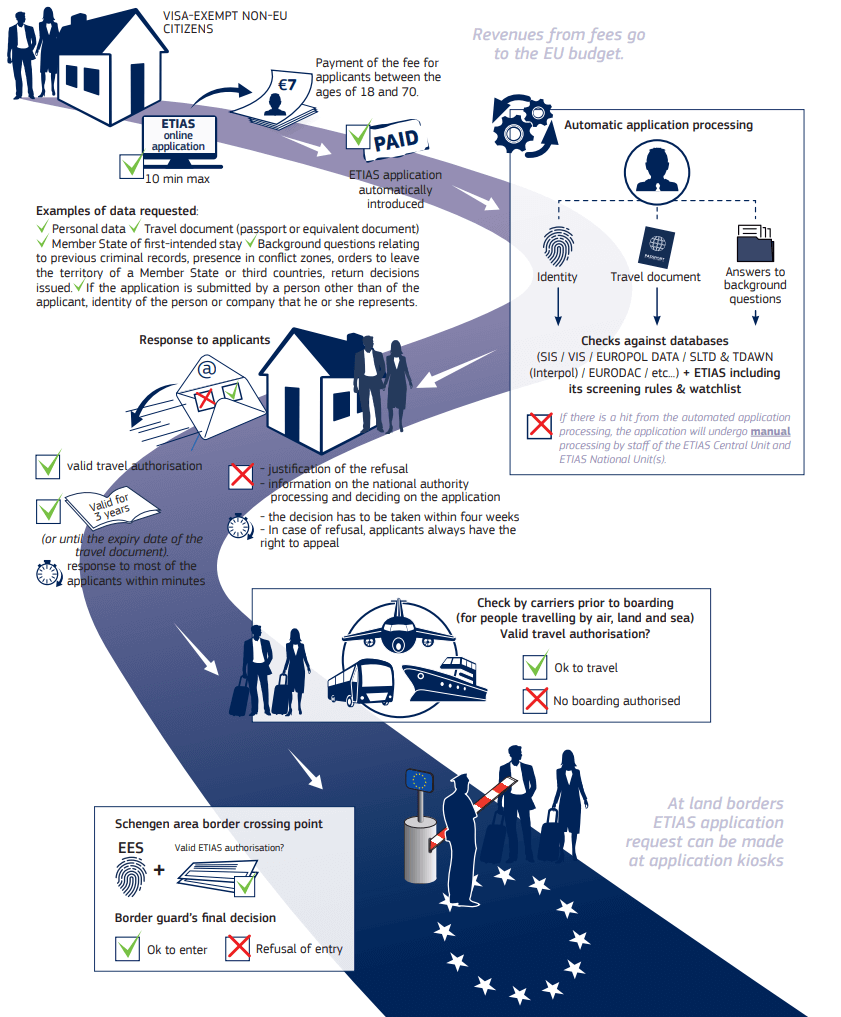ETIAS FOR COSTA RICANS
EUROPE TRAVEL AUTHORISATION FOR COSTA RICAN CITIZENS
This website is not associated with or owned by the EU. The European Union’s official website is europa.eu.
Costa Ricans do not need a visa to enter the European Schengen Area. A visa-waiver agreement between the EU and Costa Rica allows passport holders to visit the Schegen Area visa-free for a limited time.
Travel from Costa Rica to the Schengen Area without a visa is authorised for up to 90 days for tourist, business, or transit. Costa Ricans will soon require ETIAS to enter the Schengen Area without a visa. ETIAS will be operational beginning in November 2023. Costa Ricans and other visa-exempt travellers from outside the EU will soon be required to register with the European Travel Information and Authorisation System.
The Schengen Area is presently comprised of 22 European Union countries:
- EU Schengen
- Non-EU Schengen States
- Non-Schengen EU States
Non-EU Member States:
Micro-States de facto part of Schengen Area:
Non-Schengen EU States
Costa Rican citizens will be allowed to apply for ETIAS beginning in November 2023. To travel without a visa, all Costa Rican nationals must join in this programme, regardless of whether the trip is for tourism, leisure, or business.
All Schengen member countries have accepted the European Travel Information and Authorisation System (ETIAS). This approach attempts to reduce illegal immigration and increase the safety of visitors and inhabitants in Europe.
Costa Rican citizens travelling to Europe must apply for an ETIAS visa waiver online before to departure. The ETIAS application is simple to use and takes only a few minutes to complete.
APPLYING FOR ETIAS FROM COSTA RICA
Costa Ricans can apply for ETIAS via their smartphone, tablet, or desktop computer. The ETIAS registration process is simple, requiring only basic information on the passenger, their passport data, and their trip plans.
Costa Ricans must submit the following information with their ETIAS application:
- Personal data such as first name, family name, date, and place of birth
- Passport details such as the date and country of issuance, expiration date and passport number
- Travel plans such as the Schengen country you intend to enter first and travel dates
- Background questions such as health, security, and history of deportation
- Contact information such as a mobile phone number and email address
Costa Rican citizens should carefully review all of the information before submitting the ETIAS application. Any errors could result in processing delays if the information does not exactly match the passport.
Applicants will be notified via email whether the ETIAS visa waiver for Costa Rica is accepted. Travelers from Costa Rica can travel to and move between all member countries with an authorised ETIAS for up to 90 days.
VISA WAIVER REQUIREMENTS FOR COSTA RICAN CITIZENS
Costa Ricans will benefit from the ETIAS visa waiver, which will improve border management and international security for tourists and residents. Costa Rican citizens must meet the following requirements in order to register with the European Travel Information and Authorisation System:
- Costa Rican passport valid for the entire stay in the Schengen Area
- Current email address to receive ETIAS status updates
- Credit or debit card to pay the ETIAS processing fee
Costa Rican citizens will be unable to submit the ETIAS visa waiver application without these three materials.
ETIAS BENEFITS FOR COSTA RICAN NATIONALS
Costa Ricans benefit from ETIAS in a variety of ways. ETIAS, like the US ESTA programme, is intended to screen people who do not require a visa to travel, hence boosting security.
The travel authorization will be required for entry and will be validated when the passport is scanned at an external Schengen border.
This prior verification provided by ETIAS will benefit Costa Ricans in the following ways:
- Fast, online application
- No trips to the embassy or consulate
- Increased security in Schengen countries
- Reduction in the number of refusals of entry at European border crossings
ETIAS FOR COSTA RICAN CITIZENS WITH DUAL NATIONALITY
An authorised ETIAS will be electronically connected to the Costa Rican passport used to apply. ETIAS cannot be transferred from one passport to another, even if both identification documents are issued to the same individual.
This means that Costa Rican nationals with dual citizenship who have more than one valid passport must choose a single passport to apply for the ETIAS and travel to the Schengen Area.
This also means that if the passport used to apply for the ETIAS expires before the travel authorisation’s 3-year validity period expires, a new travel authorisation must be acquired using the new passport.
TRAVELLING FROM COSTA RICA TO EUROPE WITH AN ETIAS
Immigration inspectors will electronically read the travel document data upon arrival at the first Schengen Area border crossing point. This will automatically cross-check various databases, including a query to ETIAS for visa-exempt travellers.
If the traveller has registered for an ETIAS and received an authorised travel authorization before leaving Costa Rica, the border control procedure will be followed, and the passenger may be given entrance into the Schengen region if all entry conditions are met.
Visitors from all ETIAS-eligible countries who do not meet entry requirements may be denied access under the Schengen Border Code.
Holders of ETIAS can enter the member nations multiple times during the 3-year validity period.

